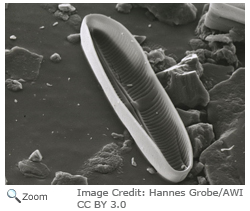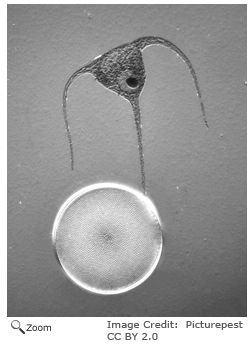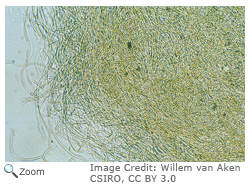Plankton |
Plankton is the foundation of the ocean food web. The word plankton comes from the Greek word "planktos" which means drifting. |
Food For All
Going With the FlowZooplankton are ocean animals that don't swim at all or are very weak swimmers, and they drift or move with ocean currents. They can be found in the sunlit zone and in deep ocean waters. Zooplankton range in size from tiny microbes to jellyfish, although most zooplankton are tiny, single-celled organisms. There are two types of zooplankton. Permanent or holoplankton will always be zooplankton. Temporary or meroplankton are made up of the larvae of fish, crustaceans and other marine animals. If they survive, they will grow into nekton or free-swimming organisms.Room to Grow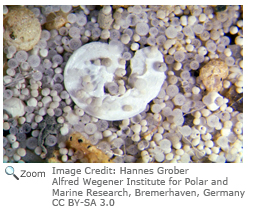 Foraminifera are tiny single-celled, shell-covered organisms, usually between a millimeter and a centimeter in diameter. As they grow, they add chambers to their shells. Depending on the species, the shell may be made of sand, calcite or organic matter. They move and catch their food with thin, hair-like extensions called pseudopodia. When foraminifera die, their shells sink to the ocean floor and form an ooze. It is estimated that 30 percent of the ocean floor is made of the shells of foraminifera. Both limestone and chalk come from foraminifera! Foraminifera are tiny single-celled, shell-covered organisms, usually between a millimeter and a centimeter in diameter. As they grow, they add chambers to their shells. Depending on the species, the shell may be made of sand, calcite or organic matter. They move and catch their food with thin, hair-like extensions called pseudopodia. When foraminifera die, their shells sink to the ocean floor and form an ooze. It is estimated that 30 percent of the ocean floor is made of the shells of foraminifera. Both limestone and chalk come from foraminifera!
Like a RockRadiolarians are small, round, shell-covered organisms. They make their shells with silica. Silica is used in making glass and can be found in minerals like quartz. They get the silica from the ocean. Radiolarians have long, sticky tentacle-like arms called pseudopodia. They stick their pseudopodia out of holes in their shells to catch phytoplankton as it floats by. When radiolarians die, their shells sink to the bottom of the ocean. Over time, if enough shells sink together, the skeletal remains can become sedimentary rock! |
Hairy Moves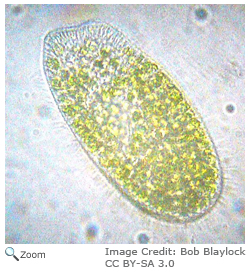 Ciliates have cilia or little hair-like extensions all around their bodies that they use to move and to catch food. There are over 8,000 species of ciliates., including paramecium. They live in salt and freshwater. Some are free swimmers, others attach themselves to organisms or objects, and some are parasites. Only the free swimming ones are considered zooplankton! Ciliates have cilia or little hair-like extensions all around their bodies that they use to move and to catch food. There are over 8,000 species of ciliates., including paramecium. They live in salt and freshwater. Some are free swimmers, others attach themselves to organisms or objects, and some are parasites. Only the free swimming ones are considered zooplankton!
Waving the FlagZooflagellates, like dinoflagellates, have long flagella. They either absorb their food or engulf it in food vacuoles or pockets. They live under many different conditions. Some are parasites and can be found in the digestive tracts of animals like the cockroach and termite; others are free swimmers. The free swimmers are zooplankton.
Jelly Belly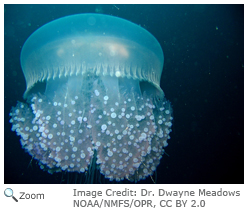 Jellyfish are also zooplankton. Jellyfish are basically big stomachs and long tentacles! Their tentacles have stingers on them and they use them to catch and paralyze food and carry it to their stomachs. They move in the water by pumping their stomachs. They mostly move up and down in the water and let the currents carry them from side to side. Jellyfish are also zooplankton. Jellyfish are basically big stomachs and long tentacles! Their tentacles have stingers on them and they use them to catch and paralyze food and carry it to their stomachs. They move in the water by pumping their stomachs. They mostly move up and down in the water and let the currents carry them from side to side.
The More the Merrier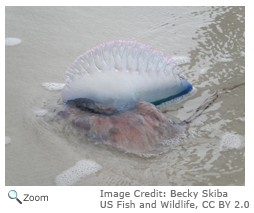 Siphonophores like the Portuguese man-of-war look like jellyfish but they are not. They are really groups or colonies of animals. Each organism in the colony has a special niche or role. Some form the tentacles, and some form the mouth and stomach. Siphonophores like the Portuguese man-of-war look like jellyfish but they are not. They are really groups or colonies of animals. Each organism in the colony has a special niche or role. Some form the tentacles, and some form the mouth and stomach.
Going Buggy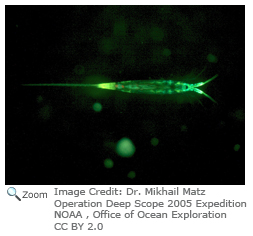 Copepods are sometimes called the insects of the sea because there are so many of them - about 10,000 species! They can be found in fresh and salt water. Copepods are very small, usually not more than a few millimeters long. The largest copepod, the Pennella balaenopterae, lives on the finback whale and can grow to be over a foot long! Copepods are crustaceans. They have two antenna, a shell and segmented bodies. They graze on phytoplankton and zooplankton. Copepods are the largest source of protein in the ocean! Copepods are sometimes called the insects of the sea because there are so many of them - about 10,000 species! They can be found in fresh and salt water. Copepods are very small, usually not more than a few millimeters long. The largest copepod, the Pennella balaenopterae, lives on the finback whale and can grow to be over a foot long! Copepods are crustaceans. They have two antenna, a shell and segmented bodies. They graze on phytoplankton and zooplankton. Copepods are the largest source of protein in the ocean! Good Eats!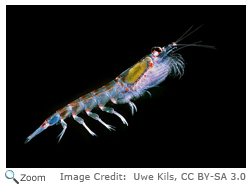 Krill, one of the ocean's smallest animals, is dinner for one of its largest, whales! There are about 82 species of krill, ranging in size from less than a quarter of an inch long to two inches long. Krill are crustaceans like copepods. They often have bioluminescent organs. They can be found in the sunlit zone and in the twilight zone. Krill, one of the ocean's smallest animals, is dinner for one of its largest, whales! There are about 82 species of krill, ranging in size from less than a quarter of an inch long to two inches long. Krill are crustaceans like copepods. They often have bioluminescent organs. They can be found in the sunlit zone and in the twilight zone.Images
|
|

